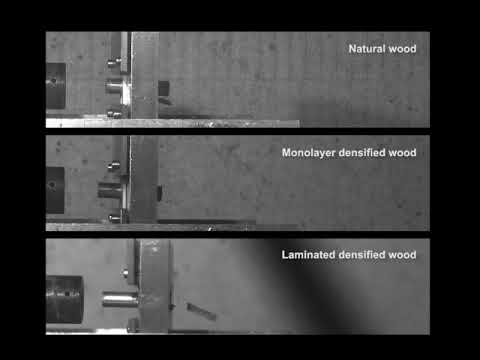While nothing can be quite as beautiful as a simple, natural piece of solid lumber, recent innovations in the area of high tech wood products celebrate just how much potential and versatility there is within a working forest. Scientists have developed a new process that can transform any species of wood into a material stronger than steel – and even some high-tech titanium alloys. According to Scientific American, this new “super material” could be used to make everything from ultra-tall wooden buildings to bullet-resistant armor plates.
Abundant, renewable and low-cost, wood is already an invaluable resource, especially in its ability to store carbon, which could help mitigate climate change. But its many uses have just expanded dramatically thanks to a strengthening treatment developed by Liangbing Hu, a materials scientist at the University of Maryland, College Park. Hu and his colleagues learned that a two-step process beginning with boiling wood in a solution of sodium hydroxide (NaOH) and sodium sulfite (Na2SO3) to partially remove lignin and hemicellulose, compressing the treated wood until its cell walls collapse and then maintaining its compression as it’s gently heated encourages the formation of chemical bonds between large numbers of hydrogen atoms and in adjacent cellulose nanofibers.
The results are impressive. The team’s compressed wood is three times as dense as the untreated substance, Hu says, adding that its resistance to being ripped apart is increased more than 10-fold. It also can become about 50 times more resistant to compression and almost 20 times as stiff. The densified wood is also substantially harder, more scratch-resistant and more impact-resistant. It can be molded into almost any shape. Perhaps most importantly, the densified wood is also moisture-resistant: In lab tests, compressed samples exposed to extreme humidity for more than five days swelled less than 10 percent—and in subsequent tests, Hu says, a simple coat of paint eliminated that swelling entirely.
A five-layer, plywood-like sandwich of densified wood stopped simulated bullets fired into the material—a result Hu and his colleagues suggest could lead to low-cost armor. The material does not protect quite as well as a Kevlar sheet of the same thickness—but it only costs about 5 percent as much, he notes.
This densified wood could offer an alternative to expensive steel, aluminum alloys and carbon-fiber alternatives, even for applications like vehicles. It remains to be seen whether the scientists can scale up and accelerate the process in order to launch it into widespread use, but if they manage to do it, the possibilities for its use are virtually endless. Imagine a future in which we’re all driving wooden cars around!


